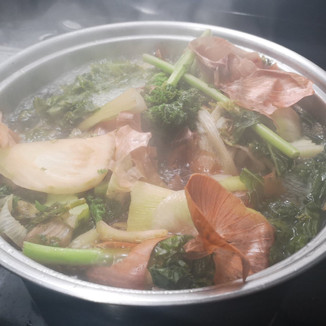Always have bone/meat stock on hand!!
- Nature IS Health

- Mar 28, 2020
- 4 min read
Updated: Aug 20
How to bring depth and nutrition into your meals
A major trend currently is the use of collagen supplements, which enhance digestion, hair, skin, nails, energy, and mental clarity, effectively improving overall health. These supplements are available in various forms, including capsules, powders, coffee creamers, and sports drinks.
The traditional method involves boiling bones from the meat you consume to create a tasty gelatinous broth.
Raw Bones
Raw bones are leftover from when we break down meat ahead of roasting it, perhaps portioning off meals for separate long-term storage. Brian has made a video on how to break down a raw chicken. These raw leftover bones, perhaps the less favorable option to roast and eat (neck, spine, tail, wing tips, feet, etc.), are delicious and produce a lot of collagen when made into a stock. Most of the time, we keep these separate from our cooked bones because it is recommended to blanch raw bones first. This step kills harmful bacteria and cleans them up a bit to produce a clearer liquid. We have skipped this step out of lack of time and still survive to tell the tale, so just something to think about.
To blanch: place bones in pot, cover with water and bring to a boil on the stove, allow to rapidly boil for 5-10 minutes. Drain this water and refill.
Cooked bones
Have you ever had leftover cooked bones, like after a roast or wing night? Instead of discarding them, rinse off any sauces and freeze them until you're ready to make stock. We usually prepare stock after roasting a whole bird, as this conveniently provides an entire carcass.
Brian's bone broth
Into a large stock pot:
Bones from about 1 chicken (check out this blog post here to learn how to break down a chicken).
We keep both raw bones like neck, feet, and cooked bones and meat scraps from our meals in the freezer for when it's time to make this recipe.
Veggie scraps- we keep onion peels, celery stems, carrot ends, general root veg scraps in the freezer with bone scraps.
Add sea salt and optional to add a splash of apple cider vinegar to help extract more nutrients.
Cover the pot and bring to a boil and then reduce to a simmer on medium heat.
Allow to simmer for 1-3 hours+. Some recipes talk about 6-12 hours, but that is the difference between a more complex broth.

ABOUT SCUM: As the stock cooks down, foamy scum will appear on the surface. No worries just skim off the surface and discard. The scum is harmless and mostly flavourless, but it is unappealing. Eventually if left unattended it will break up and disperse into the stock leaving it cloudy and a little grey. We like to have a clear stock so we remove it.
Skim the scum off the surface of the broth ever so often as you check on the pot.
When you like the colour and aroma of the broth, allow it to cool a bit and then strain the contents.
Option to return to the liquid broth to the stove and simmer uncovered to reduce down and evaporate a bit of the extra water. This makes it more concentrated, thicker and gelatinous.
Store in the fridge for 1-2 weeks, or freezer for long term.
When it cools, the fat/oil will separate from the liquid, so when you reheat it attempt to divide the oil slab evenly.
A glass of bone broth is as simple as reheating a mug of stock and adding a little sea salt.
Use this stock to make broth for soups, stirfries, crockpots and any recipe that asks for stock.
Thanks so much and enjoy!
Enjoy! Brian.

2 of our favourite cookbooks shown above: The Escoffier by Auguste Escoffier & Nourishing Traditions by Sally Fallon both with great foundational knowledge about health & food- we recommend!
Slow-cooker Chicken Broth FOR A LONGER EXTRACTION AND MORE COLLAGEN
By: Sam
The slow-cooker method is Sam's favourite.
I like to load everything up into the cooker after dinner and then forget about it until morning!
In the morning I turn off the heat and forget about it again until after work!
During the day it cools, so there's no hassle to strain right into a pot on the stove after work. Perhaps heating it up as a cup of bone-broth tea or adding some miso, bok choy and onions for quick soup- delicious and quick!
Ingredients:
Bones from 1-2, 4 pound chickens
1 onion & it's scraps
Optional veggie scraps, like stems, bottoms of herbs and unfavourable ends of your favourite veggies
2 carrots roughly chopped
2 celery pieces roughly chopped
Optional cloves of garlic, ginger or turmeric
Splash of apple cider vinegar
Water, cover the bones with at least double-triple the water
Salt and pepper to taste, other herbs
Keep in mind whatever veggies you use will end up being cooked down to nothing, the broth will be strained and the scraps and mushy veggies composted.
Tools:
Slow-cooker/crock pot
Ladle
Slotted spoon
Strainer
Jars for storage
Method:
Blanch raw bones first and then continue..
Loosely chop veggies and assemble with bones in a crock-pot.
I like to add a light dusting of herbs, I make a blend from our garden that contains sage, rosemary, thyme, marjoram, etc.
Add a dollop of apple cider vinegar, I use about 1-2 tbsp depending on how packed the crock-pot is.
Add sea salt and ground or whole pepper cloves.
Cover the mix with water and turn your slow-cooker on low. I usually do this in the evening and keep it on overnight, so for 8-10hrs.
Turn off the crock pot and allow to cool.
Strain and store in jars for up to a week or freeze for longer storage.
Enjoy! Samantha.

.png)





























Comments